
Creating and publishing content pillars on your site doesn’t have to be boring or tedious. It can actually be fun.
More importantly, if you do your job right, content pillars can help you pick up substantial organic traffic.
In this article, you’ll learn what content pillars are, why they’re important, and how to build them to improve your rankings.
To jump-start your brainstorming process, I’ll also give you examples of content pillar pages from a few different niches, so you can see what successful SEO copywriting looks like.
What Are Content Pillars and Why Are They Important?
A content pillar is an informative and authoritative page on a central theme or topic. A content pillar is the heart of a content hub, which interlinks with cluster pages that explain or explore subtopics. Together, content pillars and cluster pages provide in-depth coverage of the primary subject.
Content pillars are important because they can create a proper silo structure for your site, if you follow internal linking best practices. These critical pages can improve SEO and get you more visibility.
They also help you:
- Create a better user experience because your readers can easily navigate your site
- Keep your readers on your site, instead of bouncing away
- Find opportunities to repurpose your content
- Establish authority in your niche or industry (make sure to follow Google’s E-E-A-T and YMYL guidelines)
- Get higher engagement with your content
- Identify gaps in your content strategy
- Streamline content production
Here’s an example of how the term “SEO” might be turned into a content pillar with links to cluster pages that cover subtopics.
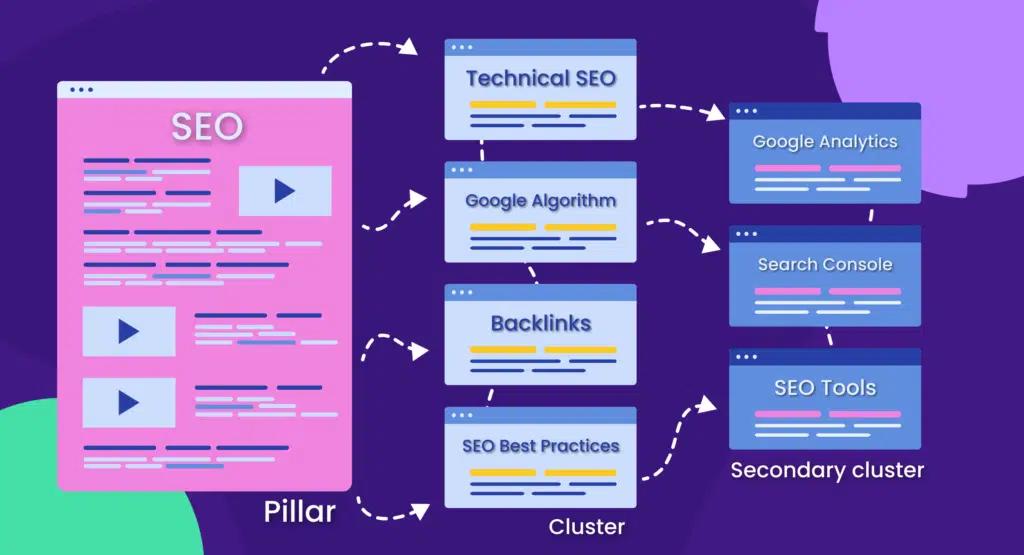
The Three Main Types of Content Pillars
The types of content pillars you’ll create will depend on your niche, but these are some excellent starting points for your content architecture.
The “How-To” Pillar Page
“How-To” pillar pages are designed to instruct and guide. They provide step-by-step guidance to help readers solve a problem or accomplish a task. The pages go beyond simple, short, how-to articles, and dive deeper to give people a comprehensive guide that addresses all aspects of the topic.
One of the main benefits of a “How-To” pillar page is its direct relevance to user intent. When someone searches for a guide or a solution, they’re often looking for detailed, actionable instructions. These pillar pages cater to that need and give your readers in-depth answers to their questions.
The Guide Pillar Page
With a “guide” content pillar page, your goal is to give the reader a complete explanation and exploration of a topic. When crafting these pages, tell your readers everything they need to know.
So, if you spot a page or post called, “The Ultimate Guide to X,” that’s probably a guide pillar page.
These types of pages are often evergreen, which means they contain timeless advice or best practices that are essential for blogs that make money.
The “What Is” Pillar Page
A “What Is” pillar page defines, describes, and explains a topic in depth. These pages demystify complex topics or terms for readers.
These pillar pages have broad appeal, from beginners to professionals who need a quick refresher.
By creating “What Is” pages, you can gain an uptick in traffic, especially if your targeted keywords get a healthy search volume.
Think about how often you ask Google, “What is X?” and get directed to a pillar page with a clear, easy-to-understand explanation.
Done well, all three of these types of pillar content can give you a significant SEO boost and make you a go-to source for information in your industry or niche.
Three Powerful Examples of Content Pillars
Want a few examples of content pillar pages?
First, you can check out Home Depot’s How to Paint a Room tutorial.
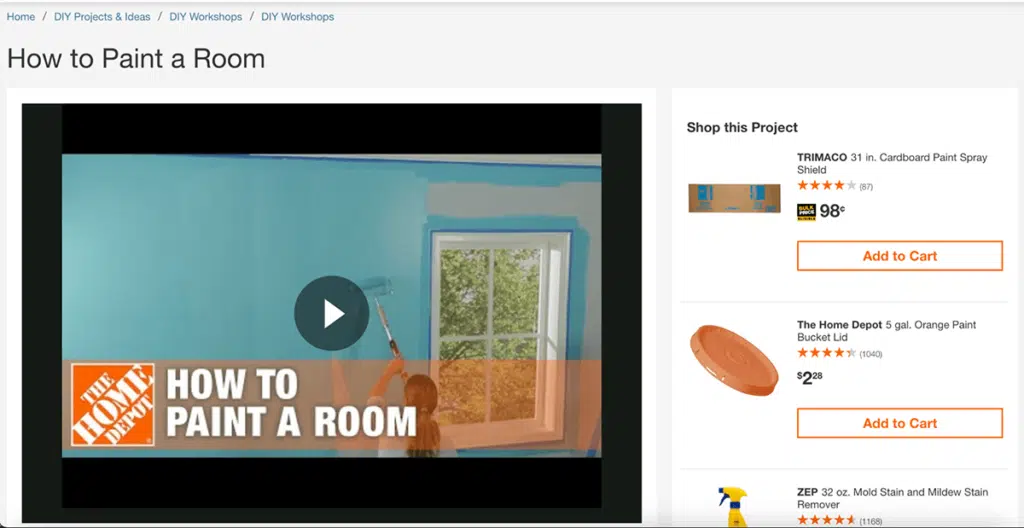
This content pillar page is going to link out to a number of subtopics on the Home Depot website that help you complete your room-painting project.
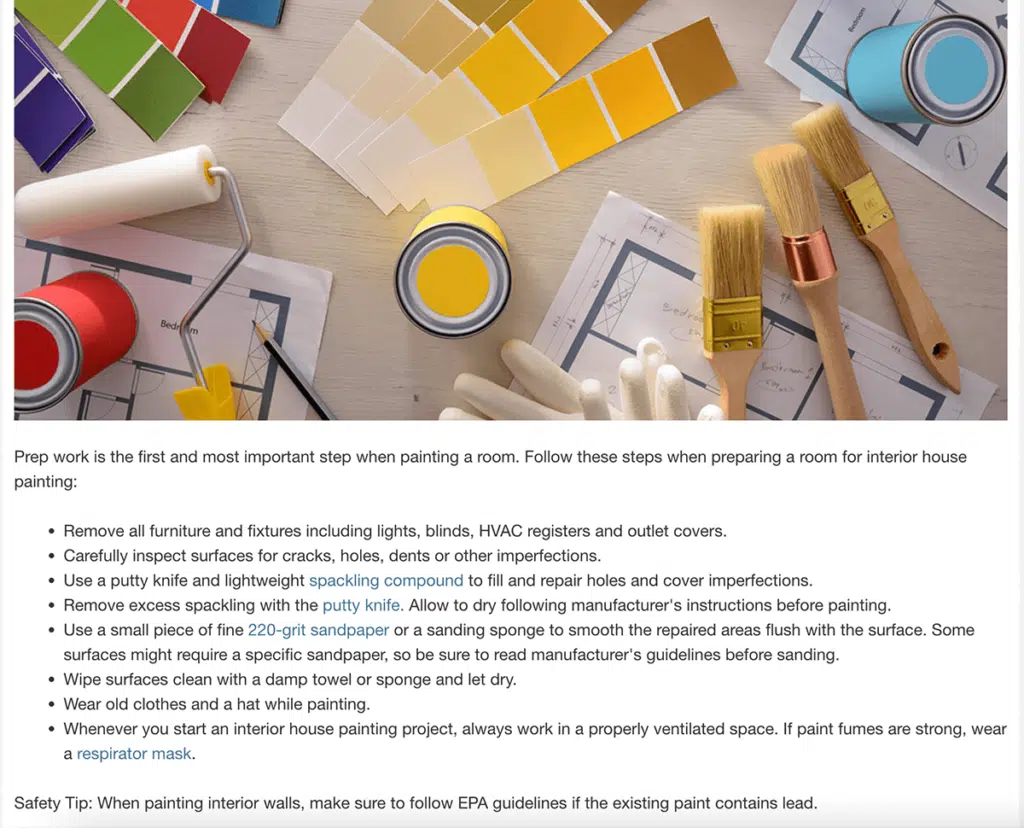
Next, check out the fitness website Realbuzz. It published The Ultimate Guide to Running a Marathon, which includes guidance on picking a race, creating a training plan, increasing your speed, and fueling up for the big day.

Finally, Semrush’s content pillar post What Is SEO? is on Page One of the SERPs for the highly competitive keyword phrase.
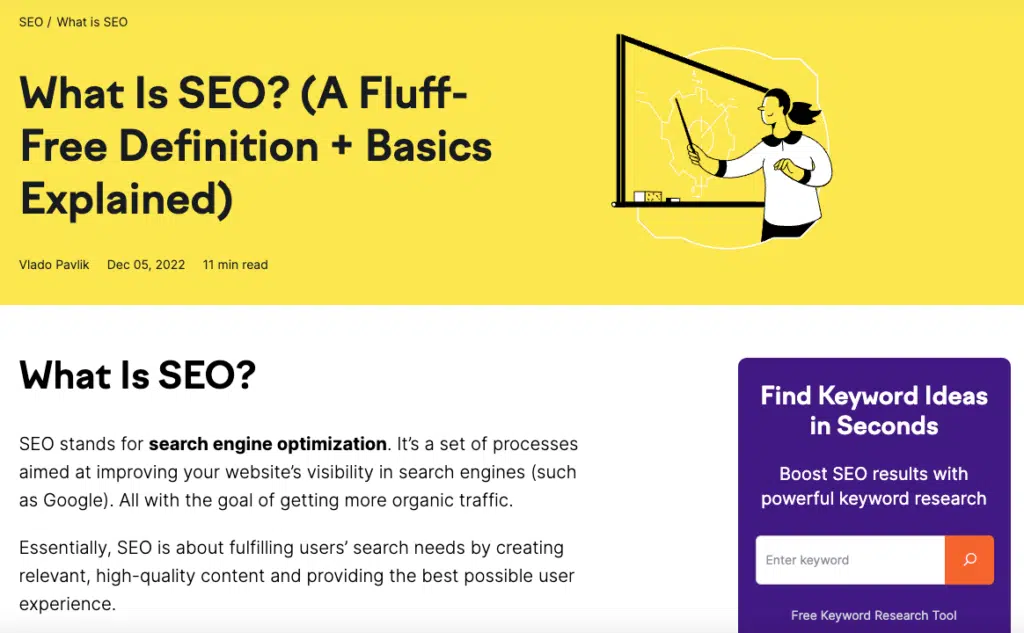
How to Build Your Content Pillar Strategy
Creating content pillars and interlinking them with cluster pages (often with low-competition keywords) can be a game-changer for your SEO and content marketing efforts.
Here’s a step-by-step guide for building a content pillar strategy.
Step #1: Identify Your Niche’s Most Fundamental Topics
Before you write a single word, you need to have a clear understanding of your customers and what they care about.
Send out customer surveys and conduct interviews to identify your audience’s biggest (and most pressing) pain points. Look for high-volume search queries and consider the needs or questions driving those searches.
Analyzing social media and online community conversations can also shed light on your audience’s demographics, online behaviors, and preferences.
As part of your research, investigate your competition and do a backlink analysis to see which of their pillar pages get the most links.
Once you’ve gathered all this information about your niche’s core topics, distill it. Prioritize subjects based on relevance and search demand. This list will be your roadmap to creating meaningful, foundational content pillars.
Remember, identifying these key topics is an ongoing process. As industries evolve and audiences’ needs shift, you’ll need to revisit and refresh your research so your content always stays relevant for your reader.
Step #2: Understand Search Intent So You Can Build the Right Type of Content
To create content that ranks well, you’ll need to understand the search intent behind key queries.
While keywords offer a glimpse into what users are searching for, knowing intent provides insights into the “why” behind those searches. Then you can make sure your content aligns with readers’ expectations.
There are four primary types of search intent:
- Informational: Users are in search of knowledge or answers. They might be asking questions or looking for explanations on specific topics. (e.g., “how to unclog a sink”)
- Navigational: With these searches, users are trying to reach a particular website or page. (e.g., “amazon login”)
- Commercial: Users are looking to make a purchase but are still in the research phase. They might be comparing products, reading reviews, or seeking recommendations. (e.g., “best cat litter box”)
- Transactional: Users are ready to buy, sign up, or engage in a specific action. (e.g., “buy toyota celica”)
To uncover the intent behind keywords, consider the phrasing of the search, but also use tools to inspect the type of content currently ranking for those terms. For example, if a search query predominantly returns how-to guides, it’s likely informational.
Understanding search intent gives you the information you need to align your content pillars not just with what your audience searches for, but what they truly need. This will help you establish trusted relationships with prospects and customers.
Step #3: Check Your Competitors for Similar Clusters
You can learn a lot about your competitors’ content marketing strategy by looking at their content pillars, and the clusters they’ve built around them.
Digging into your keyword competition can help you identify the sites that rank well for the primary keywords relevant to your niche. Examine their websites and map out the primary topics or themes they cover. Are they skimming the surface in their content or diving deep into subtopics?
How do they group related articles or pages? What pillars have they built around? Look at the hierarchy and flow of their content and links, too.
Analyzing competitors’ clusters can reveal gaps in their content — areas they might have overlooked or not addressed thoroughly. These gaps might be opportunities for you to publish content that stands out and provides value they might have missed.
But while it’s beneficial to spy on your competitors, make sure your content strategy is unique to your brand and audience.
You can use what you’ve learned from a competitor website traffic analysis as a foundation, but always tailor your approach based on your brand’s values and strengths, as well as the unique needs of your audience.
Step #4: Audit Your Existing Content
You don’t need to start from scratch when adopting a content pillar strategy. You may already have access to a treasure trove of potential pillars and clusters within your current content.
I recommend conducting a careful content audit to help you recognize these assets, reshape them, and integrate them into your pillar strategy.
Start by listing all content types, from articles to videos and infographics. Categorize them by main topic or theme and look for content concentrations and possible gaps.
Next, assess each piece’s relevance and quality. Update outdated content and keep the pieces that are still up-to-date.
Then assign content to corresponding pillars. Some pieces might align with existing content pillars, while others could prompt the creation of new ones. As you organize, map out links between topics. This will help you come up with interlinking options (which we’ll talk about in a bit).
Step #5: Create Great Resources for Your Content Pillars
Ready to create a content pillar page? Let’s go.
Pillar pages aren’t just ordinary pieces of content — they’re exhaustive resources on specific topics. They’re designed to be invaluable to your audience.
Depth is key. Your pillar page should go beyond the surface level and really dig into the nitty-gritty of the subject so that they’ll make a significant impact when you track your SEO performance.
But remember, going deep doesn’t necessarily mean adding layers of complexity.
Even when you’re exploring the details, make your content easily digestible and accessible to all readers, from novices to experts.
Include things like:
- Simple navigation (e.g., a table of contents)
- Internal links with optimized anchor text
- Bulleted or numbered lists
- Subheadings
- Images
Develop your content, edit carefully, add visuals, and hit publish.
Step #6: Develop Cluster Content by Addressing Secondary Questions and Keywords
Your content pillar page might be comprehensive and authoritative, but that’s just the beginning.
Inevitably, many smaller (but equally important) subtopics will address secondary questions and keywords related to your main pillar page.
For example, if your main content pillar is “An In-Depth Guide to Sustainable Living: Practices, Benefits, and Tips for a Greener Tomorrow,” other highly relevant questions you can address in cluster content could include:
- What are the top eco-friendly products every household should consider?
- The environmental impact of fast fashion (and sustainable alternatives)
- Solar power vs. traditional electricity: A cost-benefit analysis
- How to reduce, reuse, and recycle effectively in daily life
- Is eating a plant-based diet better for the planet?
- How families can reduce their carbon footprint
- How to support local and ethical brands
Semrush’s Topic Research Tool can make finding subtopics much easier, because you know they’re supported by actual search data. Just type your main keyword into the tool …

… then explore a number of content ideas that might be a good fit for your audience.
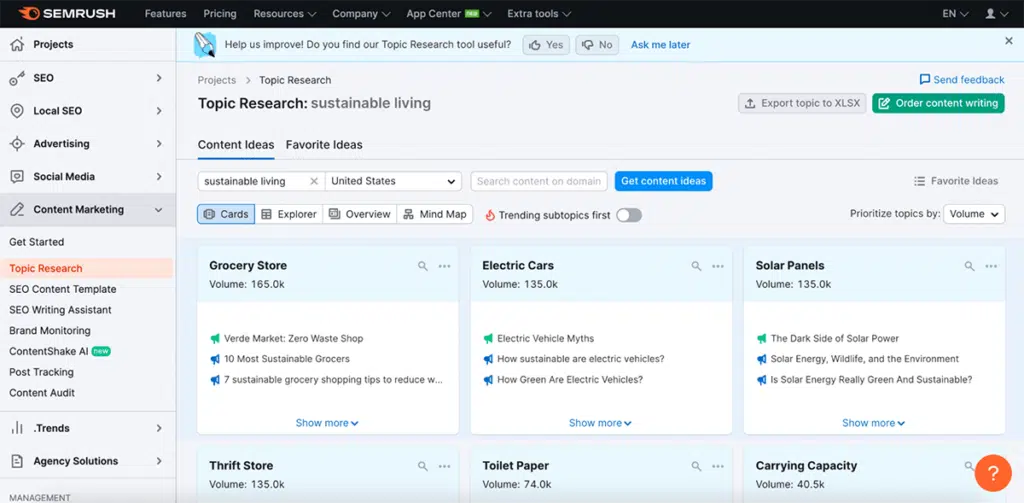
After you identify potential topics to turn into content, you can use Semrush’s Keyword Overview Tool to check search volume, keyword difficulty, and search intent to make sure the keywords are worth your time and effort.
Here’s an example from Nick’s post on long-tail keywords. The main content pillar “Drake Songs” links out to a number of clusters on related subtopics.
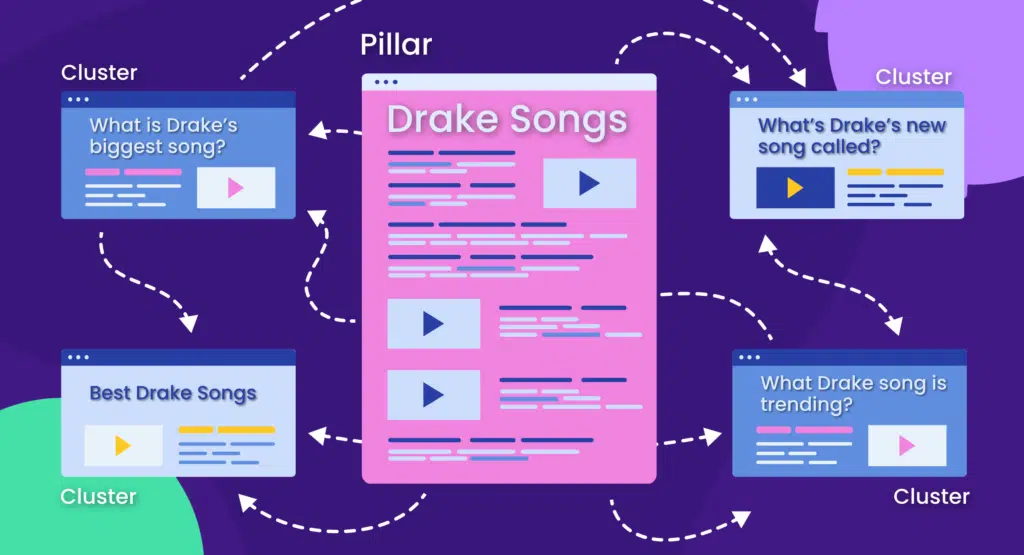
Once you’ve identified these subtopics, plan out your cluster contents — whether they’re blog posts, infographics, ebooks, videos, or podcast episodes. Then keep on creating, publishing, and optimizing.
Step #7: Interlink Your Content Using a Silo Structure
A silo structure (when you’re doing SEO) organizes website content into distinct categories or “silos,” based on subject matter.
This approach enables you to categorize content logically and helps search engines understand the hierarchy of your site and the relationship between different content pillars.
The primary objective of interlinking in a siloed setup is to reinforce the thematic consistency of each silo. This means links within a specific silo should predominantly point to other pages or articles within the same group.
When you interlink like this, you emphasize to search engines that the content within that silo is closely related and authoritative on a specific subject.
And while internal consistency is important, you should still link between silos, too. Just make sure each link offers genuine value to the reader. For instance, if an article in one silo references a concept elaborated on in a different silo, it’s worth adding a link to provide readers with a deeper understanding.
For internal links on your site, use descriptive anchor text. This lets readers know what to expect from the linked content and provides search engines with contextual clues about the linked page’s subject matter.
When you’re interlinking, don’t overdo it. Every link should serve a purpose, either for user navigation or to emphasize the thematic relevance of your content.
Aim for a balance. Your content pillars shouldn’t be so saturated with links that they become distracting or look like you’re trying to game the system.
Using Content Pillars for Social Media Marketing
Content pillars don’t just boost your search engine visibility — they also come in handy for social media marketing. Distributing content pillars on social platforms helps you anchor your brand and ensure message consistency.
Content pillars also provide an idea reservoir so planned and spontaneous posts remain on-brand. Strong pillar pages can also improve engagement and drive more traffic, because they revolve around key topics that resonate with your audience.
This relevance will attract more likes, shares, and comments.
How to Anchor Your SEO with Content Pillars
As an SEO professional, I know you’re always looking for ways to boost your organic traffic and establish a solid online presence. I firmly believe the key to both is creating an effective content strategy built on a foundation of content pillars.
Your content pillars are the backbone of your SEO strategy, giving you a clear roadmap for content creation and distribution. Whether digging into the details of a “How-To” pillar or providing clarity with a “What Is” page, your goal is to deliver value-packed, authoritative content that meets your audience’s needs.
Embracing a content pillar strategy isn’t just about boosting numbers or ticking off SEO checkboxes. It’s the key to becoming a recognized authority online. It’s also about creating a cohesive brand narrative that resonates, informs, and engages.
The future of content marketing will likely bring even more emphasis on structured, comprehensive, and authoritative content as algorithms continue to prioritize user experience and relevance.
Staying ahead of the curve means not just adopting content pillars and using a silo structure, but continually refining your content in response to audience feedback and changing industry trends.
If you’re ready to elevate your content game, start building those content pillars (and adding to them with cluster pages)! You can easily uncover what resonates with your audience, design a winning content plan, and structure your articles with Semrush’s Topic Research Tool.
Start your 7-day free Semrush trial to start generating better content ideas today!